Nablus (Shechem)
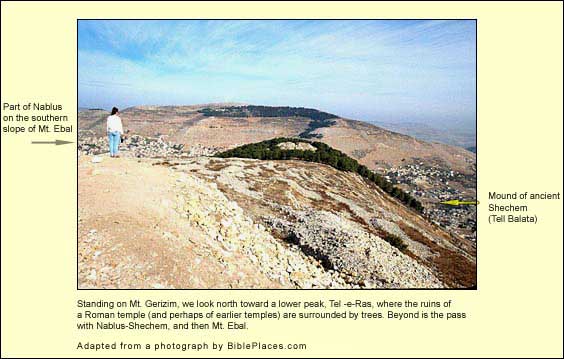
At the eastern end of the pass, Ebal and Gerizim come within 300 yards of each other, and just beyond this point, somewhat nearer the edge of Ebal, is Tell Balata, biblical Shechem, lying halfway between Dan and Beersheba.
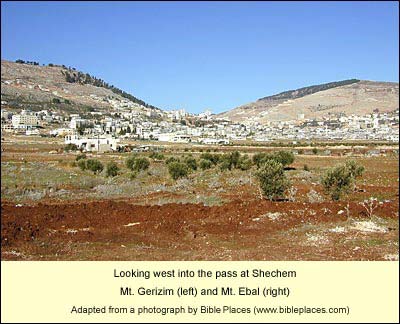
A few references will indicate the importance of Shechem: It was Abram's first destination in the land (Genesis 12:6).Abram passed through the land to the place of Shechem, to the oak of Moreh. The Canaanite was then in the land. It was also first for his grandson Jacob (Genesis 33:18).Jacob came in peace to the city of Shechem, which is in the land of Canaan, when he came from Paddan Aram; and encamped before the city. Moses appoints it as the place of the first ceremony after the Israelites cross the Jordan(Deuteronomy 11: 29-31).It shall happen, when Yahweh your God shall bring you into the land where you go to possess it, that you shall set the blessing on Mount Gerizim, and the curse on Mount Ebal. Aren’t they beyond the Jordan, behind the way of the going down of the sun, in the land of the Canaanites who dwell in the Arabah, over against Gilgal, beside the oaks of Moreh? For you are to pass over the Jordan to go in to possess the land which Yahweh your God gives you, and you shall possess it, and dwell therein. Here Joshua renews the covenant between the people and Yahweh, and here Joseph's bones are buried (Joshua 24: 1, 25, 32).So Joshua made a covenant with the people that day, and made for them a statute and an ordinance in Shechem....They buried the bones of Joseph, which the children of Israel brought up out of Egypt, in Shechem... Abimelech, son of Gideon, is crowned king at Shechem (Judges 9:3-6).All the men of Shechem assembled themselves together, and all the house of Millo, and went and made Abimelech king, by the oak of the pillar that was in Shechem. Rehoboam, son of Solomon comes here to have his kingship confirmed by the northern tribes; instead they choose Jeroboam son of Nebat, who makes it his capital (1 Kings 12:1,25).Rehoboam went to Shechem: for all Israel had come to Shechem to make him king....Then Jeroboam built Shechem in the hill country of Ephraim, and lived in it... At Jacob's well nearby, Jesus conversed with a Samaritan woman.(John 4: 4-7).He needed to pass through Samaria. So he came to a city of Samaria, called Sychar, near the parcel of ground that Jacob gave to his son, Joseph. Jacob’s well was there. Jesus therefore, being tired from his journey, sat down by the well. It was about the sixth hour. A woman of Samaria came to draw water. Jesus said to her, “Give me a drink.”
The importance of Shechem in the First Testament period derived from its position. The east-west pass between Ebal and Gerizim cuts through the spine of the central mountain range. This made possible a link between the Great Trunk Road and the King's Highway.The "King's Highway" (Numbers 21:22) was the second major trunk road. It stretched from Arabia Felix (Yemen today, then rich in perfumes and spices) through Transjordan to the great oasis at Damascus. Upon this stretch fell the last rains from the Mediterranean. Due east of the highway lay 400 miles of desert. (There were, in fact, three good links: the one through Beth Shean north of us, the one through Jericho south of us, and this middle road.) From Shechem the way continued east through a wadi, forded the Jordan at Adam, and then ascended through the Jabbok canyon to the King's Highway.
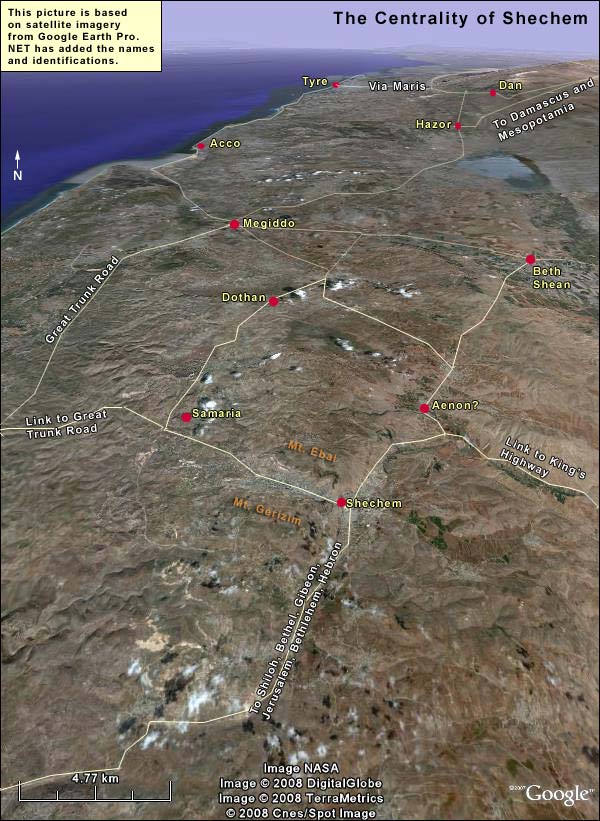
That link-road is half the story. But suppose you are coming from Galilee, and your destination is in the hill country: Jerusalem, for example. South of the Jezreel Plain, two roads skirt the mountains. We took the western one, passing the ancient city of Samaria. Our way was blocked by the long hulk of Mt. Gerizim, so we turned east through the pass, arriving at Shechem. The eastern route also leads to Shechem. From here to the south it stretches via Shiloh, Bethel, Rama, Mizpeh, Gibeon, Jerusalem, Bethlehem, as far as Hebron. This is the only good road down the central highlands, because it follows the watershed. Thus Shechem occupies a vital junction, where the east-west road (linking the international highways) joins the north-south road (through the mountain range).
With respect to international trade, cities like Hazor, Megiddo and Beth Shean were of course more important, for they lay on the Great Trunk Road. But this main thoroughfare was extremely vulnerable. Israelites, hardly a match for Egyptian or Mesopotamian armies, found greater security in the hills. (An empire could spread its sway on the horizontal plane like water, but a few hundred yards up was a different story.) That is one reason why the mountain towns like Shechem appear in the Bible more often than Hazor, etc.
We shall make two visits here:
To Tell Balata, site of the ancient city, to stand in the very first "temple of the Lord" and re-live the renewal of the covenant.
To Jacob's well.
{mospagebreak title=Ancient Shechem}
Ancient Shechem (Tell Balata)
This tell occupied a crucial position. Of the three link roadsThere were three viable east-west link roads between the international highways. The northernmost went through the valley of Beth Shean, the middle one through the pass at Shechem, and the southernmost across the Benjamin Plateau just north of Jerusalem. South of the latter, the east-west crossing was difficult and hazardous. between the international highways, the middle one goes through the narrow pass separating the mountains Ebal and Gerizim. On the eastern end of this pass sat Shechem. For anyone journeying in the mountain country, it also guarded the only really viable roads from north and south.
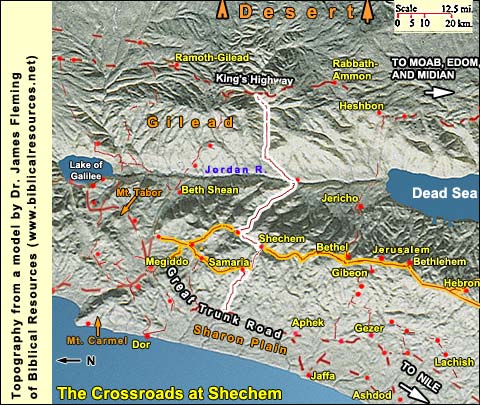
When Abram entered the land, his first destination was "the site of Shechem, to the oak of Moreh" (eilon moreh, Genesis 12:6).Abram passed through the land to the place of Shechem, to the oak of Moreh. The word moreh, in biblical use, meant "oracle" or "soothsaying." Under this tree Jacob buried the foreign gods of his household ((Genesis 35:4).They gave to Jacob all the foreign gods which were in their hands, and the rings which were in their ears; and Jacob hid them under the oak which was by Shechem. In Deuteronomy 11:29-32,It shall happen, when Yahweh your God shall bring you into the land where you go to possess it, that you shall set the blessing on Mount Gerizim, and the curse on Mount Ebal. Aren’t they beyond the Jordan, behind the way of the going down of the sun, in the land of the Canaanites who dwell in the Arabah, over against Gilgal, beside the oaks of Moreh? For you are to pass over the Jordan to go in to possess the land which Yahweh your God gives you, and you shall possess it, and dwell therein. Shechem is not mentioned, but the trees (eilonei moreh) appear to designate it. Joshua later writes the words of the covenant on a great stone, which he sets "under the oak that was by the sanctuary of Yahweh" at Shechem (Joshua 24:26). The present Arabic name for the tell, balata, immediately suggests to native speakers a paving stone or tile, but it probably comes from the Arabic balut, meaning oak. If so, then the sacred tree, long gone, is preserved in the name.
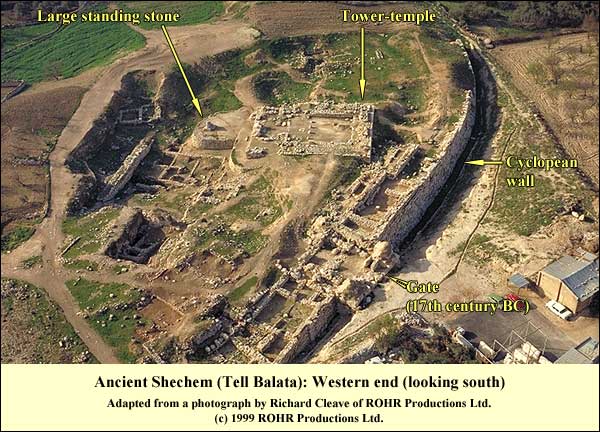
For all the advantages of its location, Shechem was low and vulnerable. This may be the reason why it so often yielded to newcomers, e.g., to Jacob and his family, to Joshua and the Israelites (for no battle is recorded), and to Abimelech son of Gideon.Judges 9:1-6. Abimelech the son of Jerubbaal went to Shechem to his mother’s brothers, and spoke with them, and with all the family of the house of his mother’s father, saying, “Please speak in the ears of all the men of Shechem, ‘Is it better for you that all the sons of Jerubbaal, who are seventy persons, rule over you, or that one rule over you?’ Remember also that I am your bone and your flesh.” His mother’s brothers spoke of him in the ears of all the men of Shechem all these words: and their hearts inclined to follow Abimelech; for they said, “He is our brother.” They gave him seventy pieces of silver out of the house of Baal Berith, with which Abimelech hired vain and light fellows, who followed him. He went to his father’s house at Ophrah, and killed his brothers the sons of Jerubbaal, being seventy persons, on one stone: but Jotham the youngest son of Jerubbaal was left; for he hid himself. All the men of Shechem assembled themselves together, and all the house of Millo, and went and made Abimelech king, by the oak of the pillar that was in Shechem. Although Jeroboam made it his capital, he quickly left it and built another, and the kings after him did not return. This vulnerability was also the factor that led the inhabitants to build the huge wall, dubbed "Cyclopean," for it must have taken a giant like the Cyclops to move the stones we see. (Outside the wall the ground was lower than it is today; much fill was poured in to build the modern road.) The wall was built at a time of major fortification throughout the country, corresponding to the domestication of the horse. People from this land (whom the Egyptians called "Hyksos," foreign rulers) had then taken over Egypt. On the conventional dating, that would have been about 1650 BC.
We note too the gate in the wall. Some of the mud brick is still left on the piers, though the rains, each year, take a little more away. It may have been the gate in which Hamor the Hivite and his son Shechem persuaded the males of the city to circumcise themselves, that they might intermarry with Jacob's clan. (Genesis 34).
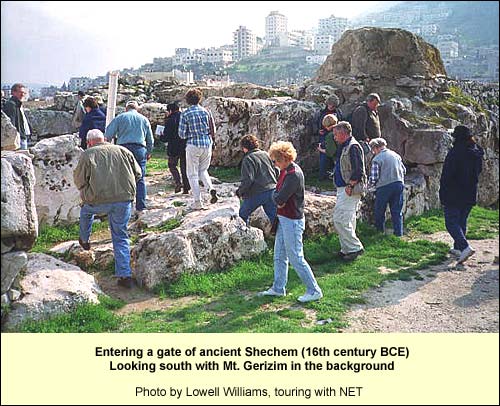
Going in through this gate, we head right (south) until we find ourselves within an outline of walls. At one stage, we shall see, this was the temple of Yahweh (mikdash yhwh) referred to in Joshua 24: 26, which stood near the oak where Joshua set the great stone. (Translators sometimes use circumlocutions.)
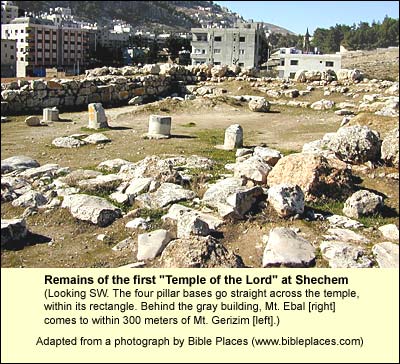
The lower sections of these ruined walls are five yards thick, so they must have supported a towering structure. They date from the same time as the Cyclopean city wall.
In front of this temple, archaeologist Ernst Sellin (in 1926-28) found standing stones (Heb. matzevot), which signified the presence of the divine. Just outside, in the forecourt, was an altar approached by a ramp. This tower-temple was destroyed along with the city, presumably by the Egyptians when they drove out the Hyksos. After a period of abandonment, city and temple rose again. In the forecourt Sellin found an altar and a huge standing stone. Could this have been the one that Joshua set up? We shall never know. Outraged at the notion that this might be it, Sellin's successor had it thrown into the dump and it broke. That is why we see only part of it today. One hopes it is standing where Sellin found it: all his field records and the draft of his final report went up in flames during World War II amid the bombing of Berlin. An expedition from Drew University, McCormick Theological Seminary and Harvard re-studied the tell and the temple from 1956 - 1968. Upon their work we depend.
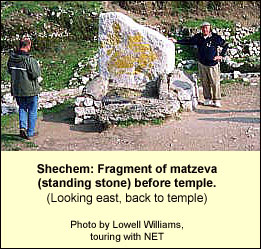
How can we know that this was the temple of the Lord mentioned in Joshua or the "temple of El-berith" (God of the covenant) mentioned in the Abimelech story (Judges 9:46, quoted below)? First, it was built before the country underwent a dramatic decline in settlement, a decline attested by archaeological surveys carried out in the 1980's. Then came a burst of settlement activity, out of which arose the towns of biblical Israel. Throughout this period, the temple at Shechem must have endured, because we hear of its destruction only at the time of Abimelech, son of Gideon (Judges 9:46-49):
When all the men of the tower of Shechem heard of it, they entered into the stronghold of the house of Elberith. It was told Abimelech that all the men of the tower of Shechem were gathered together. Abimelech went up to Mount Zalmon, he and all the people who were with him; and Abimelech took an axe in his hand, and cut down a bough from the trees, and took it up, and laid it on his shoulder: and he said to the people who were with him, “What you have seen me do, make haste, and do as I have done!” All the people likewise each cut down his bough, and followed Abimelech, and put them at the base of the stronghold, and set the stronghold on fire on them; so that all the people of the tower of Shechem died also, about a thousand men and women. The Israelites did not conquer Shechem (or any town in the tribal territory of Manasseh). Apparently, they didn't have to. But according to the Bible, it became at once a major center. (Deut. 11:29-32) Just west of us, the mountains of Ebal and Gerizim almost touch -- the pass is only 300 yards wide. It is quite conceivable that the Levites stood in it, before the temple, shouting the laws to the tribes on the slopes. So we have Deuteronomy 27: 12-26,
"When you cross the Jordan, these shall stand on Mount Gerizim to bless the people: Simeon, Levi, Judah, Issachar, Joseph, and Benjamin. For the curse, these shall stand on Mount Ebal: Reuben, Gad, Asher, Zebulun, Dan, and Naphtali. The Levites shall then answer and say to all the men of Israel with a loud voice,
‘Cursed is the man who makes an engraved or molten image, an abomination to Yahweh, the work of the hands of the craftsman, and sets it up in secret.’ All the people shall answer and say, ‘Amen.’
‘Cursed is he who sets light by his father or his mother.’ All the people shall say, ‘Amen.’
‘Cursed is he who removes his neighbor’s landmark.’ All the people shall say, ‘Amen.’
‘Cursed is he who makes the blind to wander out of the way.’ All the people shall say, ‘Amen.’
‘Cursed is he who withholds justice from the foreigner, the fatherless, and the widow.’ All the people shall say, ‘Amen.’
‘Cursed is he who lies with his father’s wife, because he has uncovered his father’s skirt.’ All the people shall say, ‘Amen.’
‘Cursed is he who lies with any kind of animal.’ All the people shall say, ‘Amen.’
‘Cursed is he who lies with his sister, the daughter of his father, or the daughter of his mother.’ All the people shall say, ‘Amen.’
‘Cursed is he who lies with his mother-in-law.’ All the people shall say, ‘Amen.’
‘Cursed is he who strikes his neighbor in secret.’ All the people shall say, ‘Amen.’
‘Cursed is he who takes a bribe to kill an innocent person.’ All the people shall say, ‘Amen.’ ‘Cursed is he who doesn’t confirm the words of this law to do them.’ All the people shall say, ‘Amen.’”
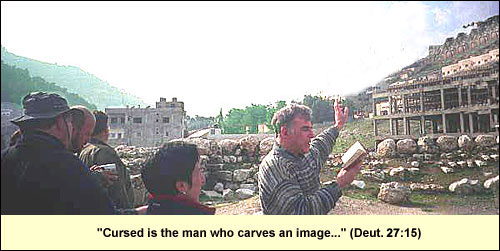
Each of the laws is brief and rhythmical, as if written to be chanted. They are not in the long, casuistic form that we find elsewhere, for example, in Exodus 21 and 22“If you buy a Hebrew servant, he shall serve six years and in the seventh he shall go out free without paying anything. If he comes in by himself, he shall go out by himself. If he is married, then his wife shall go out with him. If his master gives him a wife and she bears him sons or daughters, the wife and her children shall be her master’s, and he shall go out by himself." The laws continue in this form through Exodus 22:26. or the code of Hammurabi: if someone does such-and-such, then such-and-such will be his punishment. Rather, they are absolute and comprehensive in nature, as in the most famous example, the Ten Commandments. It is unique, in the ancient Near East, to find laws of this "apodictic" form at the national level. Such laws alone could be pronounced aloud and heard by a large group of people.
Albrecht AltAlbrecht Alt, Essays on Old Testament History and Religion, New York: Doubleday Anchor, 1968., a German scholar, has suggested that Israel held a regular ceremony of covenant renewal at Shechem between Ebal and Gerizim. That would connect to the biblical name for the temple: El-berith, the God of the covenant. In Joshua 24: 25-28, we read that Joshua summoned the tribes to Shechem and renewed the covenant:
So Joshua made a covenant with the people that day, and made for them a statute and an ordinance in Shechem. Joshua wrote these words in the book of the law of God; and he took a great stone, and set it up there under the oak that was by the sanctuary of Yahweh. Joshua said to all the people, “Behold, this stone shall be a witness against us; for it has heard all the words of Yahweh which he spoke to us. It shall be therefore a witness against you, lest you deny your God.” So Joshua sent the people away, every man to his inheritance.
("Sanctuary of Yahweh" translates the Hebrew mikdash yhwh. The usual translation of mikdash is "temple.")
Here, between Ebal and Gerizim, is a place to consider the tension between Word and Earth in Ancient Israel.
Logistics
For security reasons, one should check with the Israeli and Palestinian authorities before visiting Nablus/Shechem.
For opening hours at the tell, one may phone these numbers at the Palestinian Antiquities Authority: 050-636199 or 09/2391065 or 2958484. Fax: 09/2374690
{mospagebreak title=Jacob's Well}
Jacob's Well
"Jacob's well is one of the authentic Christian sites: its identity with what is told in the New Testament is not subject to doubt" (Madrich Yisra'elMadrich Yisrael (The Guide to Israel [Hebrew]) Jerusalem: Keter, 1980 Vol. 8, p. 384).
There are a number of reasons for this certainty, but the basic one is that wells do not move, and this is the only well in the region. Indeed, it is strange to find a well here, since there are many springs nearby. In the 1860's and 70's, British explorers heard water gushing everywhere in the pass between Ebal and Gerizim, where there are more than twenty springs. Remains of water-driven flour mills are visible there. According to John 3:23, the Baptist "was baptizing in Aenon near Salim." Salim is the name of a village three miles east of Shechem, and Aenon means springs. "Aenon near Salim" may have been four large springs on the eastern edge of Mt. Gerizim.
John's Gospel locates the well at a town called Sychar, whose name is preserved in the village of Askar, a kilometer to the north. Sychar too had a spring. The Mishnah calls it Ein Sychar, "the spring of Sychar." (And see G.A. Smith,George Adam Smith, The Historical Geography of the Holy Land, 30th edition, Jerusalem: Ariel, 1974 pp. 240 - 246.)
With so many springs, why would anyone go to the trouble of digging a vertical shaft 137 feet into the earth?
Yet someone did, for here it is.
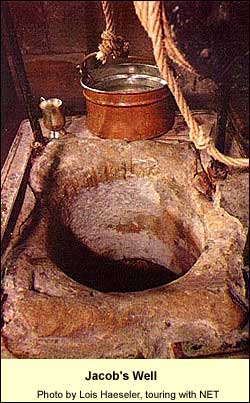
The British explorers quote a medical missionary, Dr. H.J. Bailey: "The respective qualities of various supplies of water are a favourite topic with Easterners, and in a hot climate, where other beverages are almost unknown, the natives are great connoisseurs. From the nature of the soil the springs at Nablus are mostly of very hard water, 'heavy' as the natives say. Not unjustly they attribute many of their complaints to this, and long for the 'light' waters of Gaza and other places. Now Jacob's Well has among them the repute of containing cool, palatable, refreshing water, free from the deleterious qualities of their other supplies. Frequently I have been told that after a hearty meal (which with them is appalling) a draught of this water will disperse the feeling of abnormal fulness in a short time. The fountain at El-'Askar gushes from the limestone of Mount Ebal, and is of particularly hard or 'heavy' water. ....It is not uncommon in the East to send a great distance for drinking water, especially among those who can afford to do so" (Palestine Exploration Fund Quarterly, 1897, p. 149 ff., quoted in G.A. Smith,George Adam Smith, The Historical Geography of the Holy Land, 30th edition, Jerusalem: Ariel, 1974 pp. 245-46).
It was the quest for better water, then, that may have led someone to dig this well, just as it led the woman to travel more than half a mile for it, passing springs on her way.
John 4:5-6So he came to a city of Samaria, called Sychar, near the parcel of ground that Jacob gave to his son, Joseph. Jacob’s well was there. locates the well in Sychar, "near the parcel of ground that Jacob gave to his son Joseph; and Jacob's well was there." Both Genesis 33:19 Jacob came in peace to the city of Shechem, which is in the land of Canaan, when he came from Paddan Aram; and encamped before the city. He bought the parcel of ground where he had spread his tent, at the hand of the children of Hamor, Shechem’s father, for one hundred pieces of money.and Joshua 24:32They buried the bones of Joseph, which the children of Israel brought up out of Egypt, in Shechem, in the parcel of ground which Jacob bought of the sons of Hamor the father of Shechem for a hundred pieces of money. They became the inheritance of the children of Joseph. refer to this plot of ground. Despite the circuitous drive we take today, the well is a stone's throw from Tel Balata, ancient Shechem, and the traditional Joseph's Tomb. We might be tempted with St. Jerome to identify Sychar with Shechem, but two of his predecessors, Eusebius of Caesarea and the Pilgrim of Bordeaux, take care to distinguish the two while placing them very near.
In any case, there simply is no other well in the region. The Byzantines built a cross-shaped church with the well in its center. Its remains became the crypt of a Crusader church. The Greek Orthodox restored this crypt in the nineteenth century: in it we stand when we visit the well today. In 1914 they began to rebuild the church itself, but their money came largely from Tzarist Russia, and the revolution stopped the flow. Since the collapse of the Soviet Union in 1990, they have resumed the work.
"The well is deep," said the woman. It is about 115 feet (35 meters) to the surface of the water and 137 feet (42 m.) to the bottom. Here we may read the text.
Logistics
For security reasons, one should check with the Israeli and Palestinian authorities before visiting Jacob's Well.
Modest dressShoulders covered, legs covered below the knees. required.
Open: 9:00-12:00, 14:00-16:00 (17:00 in summer). It is often open in the break as well.
Rest rooms available for a small fee.
Telephone: 09-2375123